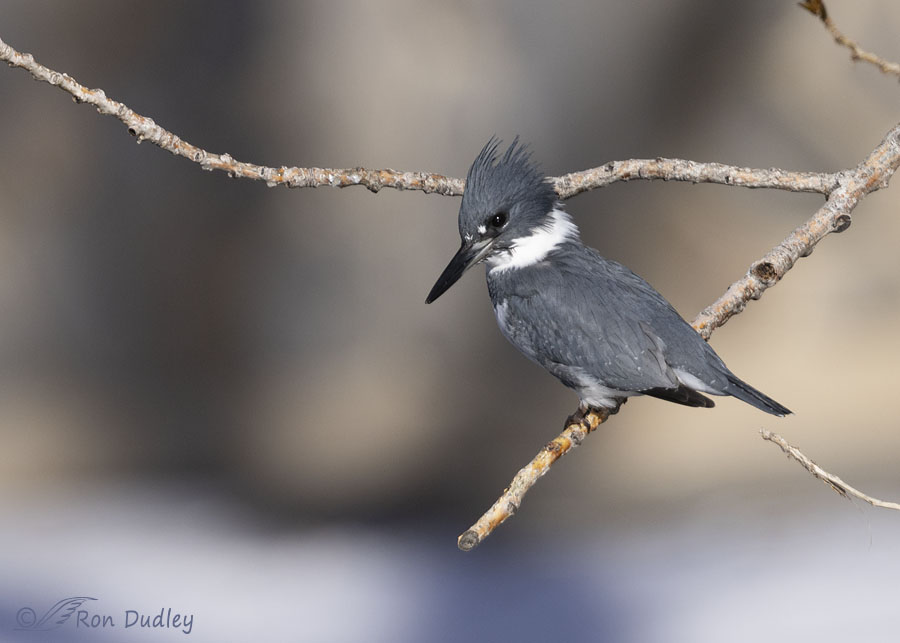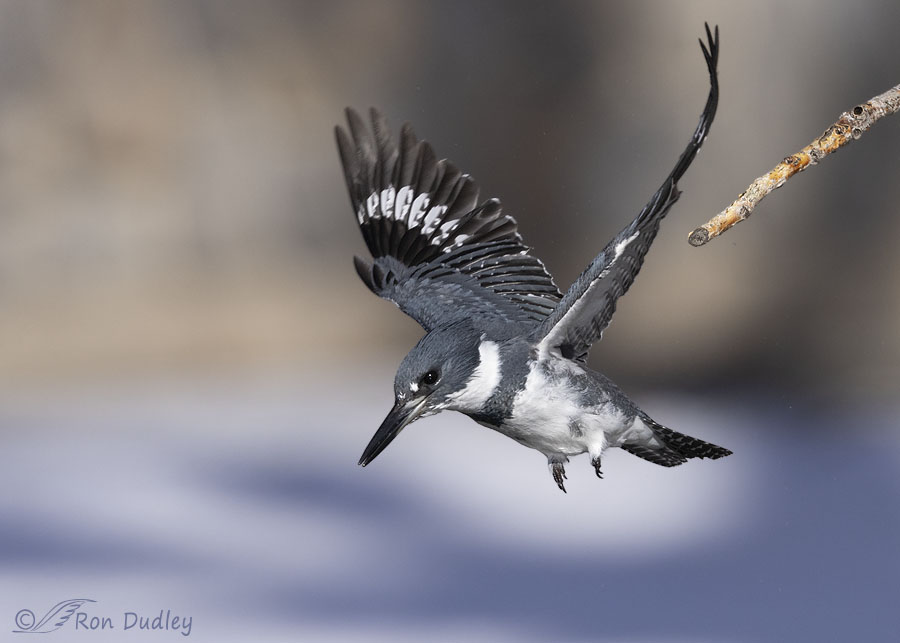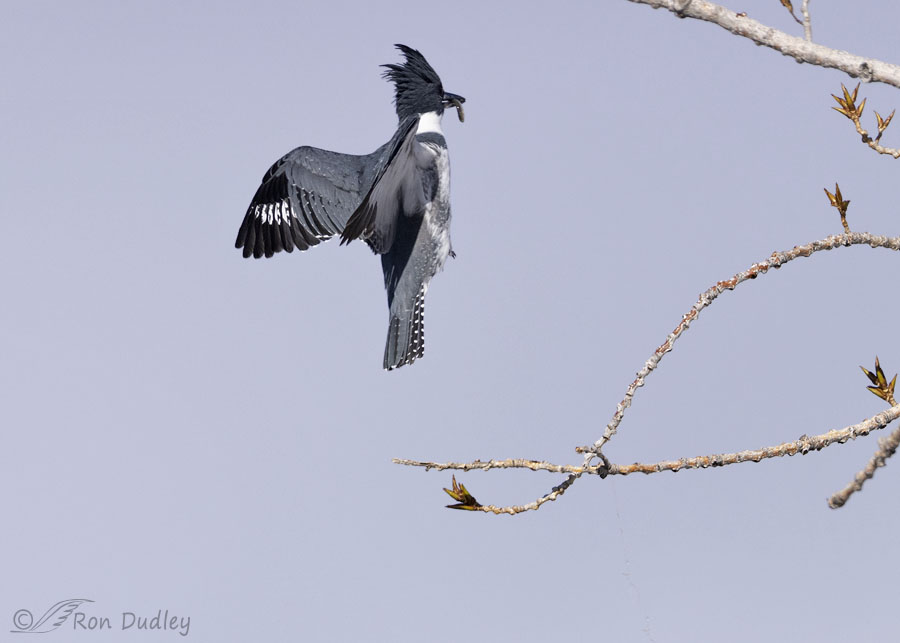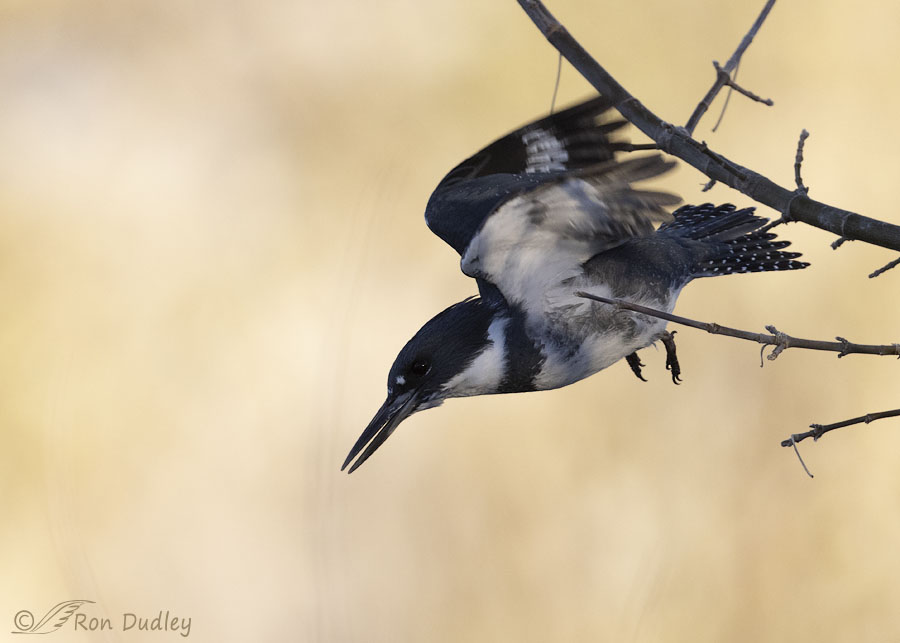Same kingfisher as in yesterday’s post but this time he’s diving on a fish instead of flying off.

1/5000, f/6.3, ISO 640, Canon R5, Canon EF500mm f/4L IS II USM + 1.4 tc, not baited, set up or called in
During my brief attempt to photograph birds two days ago I actually got two photos I like quite a lot of the male Belted Kingfisher I posted a photo of yesterday. But this isn’t one of them. I’m only including this shot to set the stage for the next one.
Here he’s fishing above a pond and fairly close to its surface. It had snowed the night before, so we see partially shaded snow at the bottom of the frame near the pond’s edge. When I took this shot he had just spotted a small fish below him and was about to go after it.

1/5000, f/6.3, ISO 640, Canon R5, Canon EF500mm f/4L IS II USM + 1.4 tc, not baited, set up or called in
I got three photos of him diving after the fish but I like this one best, in part because the other two aren’t quite as sharp.
In my portfolio of kingfisher takeoff and flight shots, this one is unusual in a variety of positive ways. The setting isn’t cluttered with branches, the perch he’d been fishing from is sharp, colorful, isolated and (I think) attractive and I really like the colors and mix of shadows and light in the background.
As in the photo I posted yesterday, the alula on his right wing is flared and prominent but what really catches my eye is his incredibly stubby legs. If I didn’t know kingfishers as well as I do, and I couldn’t see his toes, I might wonder if some pissed-off larger fish he’d attempted to catch had turned the tables on him and bitten off parts of his legs and feet.
Oh, and in case you’re wondering…

1/8000, f/6.3, ISO 640, Canon R5, Canon EF500mm f/4L IS II USM + 1.4 tc, not baited, set up or called in
he caught the fish, small as it was. He quickly swallowed it with his back to me.

1/3200, f/5.6, ISO 1600, Canon R5, Canon EF500mm f/4L IS II USM + 1.4 tc, not baited, set up or called in
Late yesterday afternoon I went looking for him again. I found him too, but this time he was in a different area and he insisted on fishing from a shaded perch. I hoped that if I caught him taking off or in flight I’d get him in the light but that didn’t happen.
But I’ll tell you what – this guy is a helluva fisherbird. During my two sessions with him over two days I saw him dive on a fish at least a dozen times and I never did see him come up empty. Not once.
Ron


Sensational series Ron!
Charlotte Norton
Thanks, Charlotte.
Late in the day, but Lyle’s “Wizard of Id” analogy is PERFECT!
(So are the photos!)
Thanks, Carolyn. From us both.
Even later in the day but yes the Wizard of I’d! But you know who does NOT like that analogy? The kingfisher who is giving all of us the evil eye in your first picture
Id not I’d. Evil eye to you auto correct.
Frances, I was about to correct your typo for you but your second comment made me smile so I’ll leave both of your comments as they are. And you may be right about the kingfisher.
With prey that size, I’d imagine his entire day is spent fishing in order to get his fill so it’s very good he’s so successful at it. The second image is wonderful, but it’s #3 that intrigues the most, since you don’t often see a bird “standing” straight up in mid-air—that crown, those wings! ♥️
Thanks, Chris. Very good point in your first sentence.
Another day of delightful kingfisher shots! Two alulae up!
 Glad he’s been so successful. Hopefully, that means you’ll find him there again.
Glad he’s been so successful. Hopefully, that means you’ll find him there again.
I especially like his body position in the second shot. It looks like he jumped off the branch as opposed to the usual dive bomber pose as in the last shot. I think the third shot is my favorite, though. I generally think of Belted Kingfishers as no-neck, stubby birds — legs included, but he’s doing his best Stretch Armstrong (remember those toys?) impression, topped off by that perfect “bed head.”
“Two alulae up” – perfect, Marty. Alulae are actually considered to be similar to thumbs in some ways.
No, I don’t remember Stretch Armstrong toys but I know what you mean.
Love the vertical shot! Simply awesome!
Thank you, Connie.
It’s great to see the nice kingfisher photos you have had in recent years. It’s one of those birds that always avoided my camera lens. That rattling call too often seemed like it was laughing at me. “HA. You missed again”
The legs and feet always do look small but they are definitely strong. They dig a nest burrow in the bank that can be 6 feet long or more. It can take a week or more to dig it out but they do a good job of it.
Dan, I often see where their nest burrow entrances are from great distances but they’re always on private land so I can’t get a good look at them. I would never approach their burrows closely but I’d sure like to get a little closer.
I’m convinced they ARE laughing at us. Or at least scolding us.
Kingfishers (well, one Kingfisher) two days in a row. What a treat.
Interesting butter-colored background in the last photo. Despite the shaded perch you still managed an eye catch.
I rotated the third photo 90º. Still works. Kind of.
It took me a minute to realize what those preternaturally truncated legs reminded me of: the king in the Wizard of Id comic strip. Other than the legs and reference royale in both names, they also share the head gear, although the Kingfisher’s is clearly superior.
Lyle, that butter color in the last photo was a result of the very warm light (not long before sunset) shining on dead vegetation in the background.
I’m unfamiliar with the Wizard of Id.
Here he is — pretty apt comparison, although I’m sure the kingfisher is a much nicer bloke. https://johnhartstudios.com/meet-the-actors/theking/
Now I remember seeing it, somewhere…
Thanks for including the vertical photo with the fish in the Kingfisher’s mouth! He’s flying straight up!
Yes, almost straight up. Which is why he’s so close to the frame edge. I almost missed him.
Excellent photos and education as always. It has always seemed remarkable to me the comparison body size and then the large beak and the tiny little feet. Also what vision they have to see those very small fish down in the water.
Are you sure you didn’t have a fish in a jar down in the water to entice him? Just joking of course, but still remember you mentioning that a few years back as a very unethical and cruel practice used by some.
I’m sure, Everett. Good memory though.
Thanks for the additional photos of this amazing bird. These new shots reminded me of how disproportionally small – compared to other body parts – the legs and feet are on Kingfishers. All a part of what makes them so amazing.
Glad you enjoyed them, Michael.
Thanks to yesterday’s post, I looked for and found the alula in today’s photo. Those feet and legs are amazing. They do seem to stick to particular areas. There’s one that sits on a wire along a certain road I drive; every time I pass that way, there’s the bird.
Shoreacres, one of the first kingfishers I ever tried to photograph habitually fished from a wire. Never did get any decent shots of that one but it wasn’t for lack of trying.
My father would have described him as having ‘ducks disease’ (His bum is too close to the ground). Those are very, very short little legs but he obviously doesn’t need them to be a totally mighty hunter.
“Ducks disease” – now that’s a new one on me, EC. I like it.
I always worry about you when you’re up this late…
My father had a turn of phrase didn’t he? And don’t worry – and thanks for your concern.
With luck I will get to sleep again before long.
OK then, consider the luck sent your way.
Ha! The first thing I noticed was its little dinky feet. Then I got to appreciate the way you stopped the action and obtained great feather detail at the beginning of its dive.
Kenneth, no matter how often I see how short their legs are they still grab my eye every time I see them.
That’s a really handsome dude-bird and I know how exciting and satisfying it can be to watch them succeeding in their hunt for food. Sharing small triumphs like these are a part of what gives life zest.
What would we do without some zest in our lives? Thanks, Granny Pat.